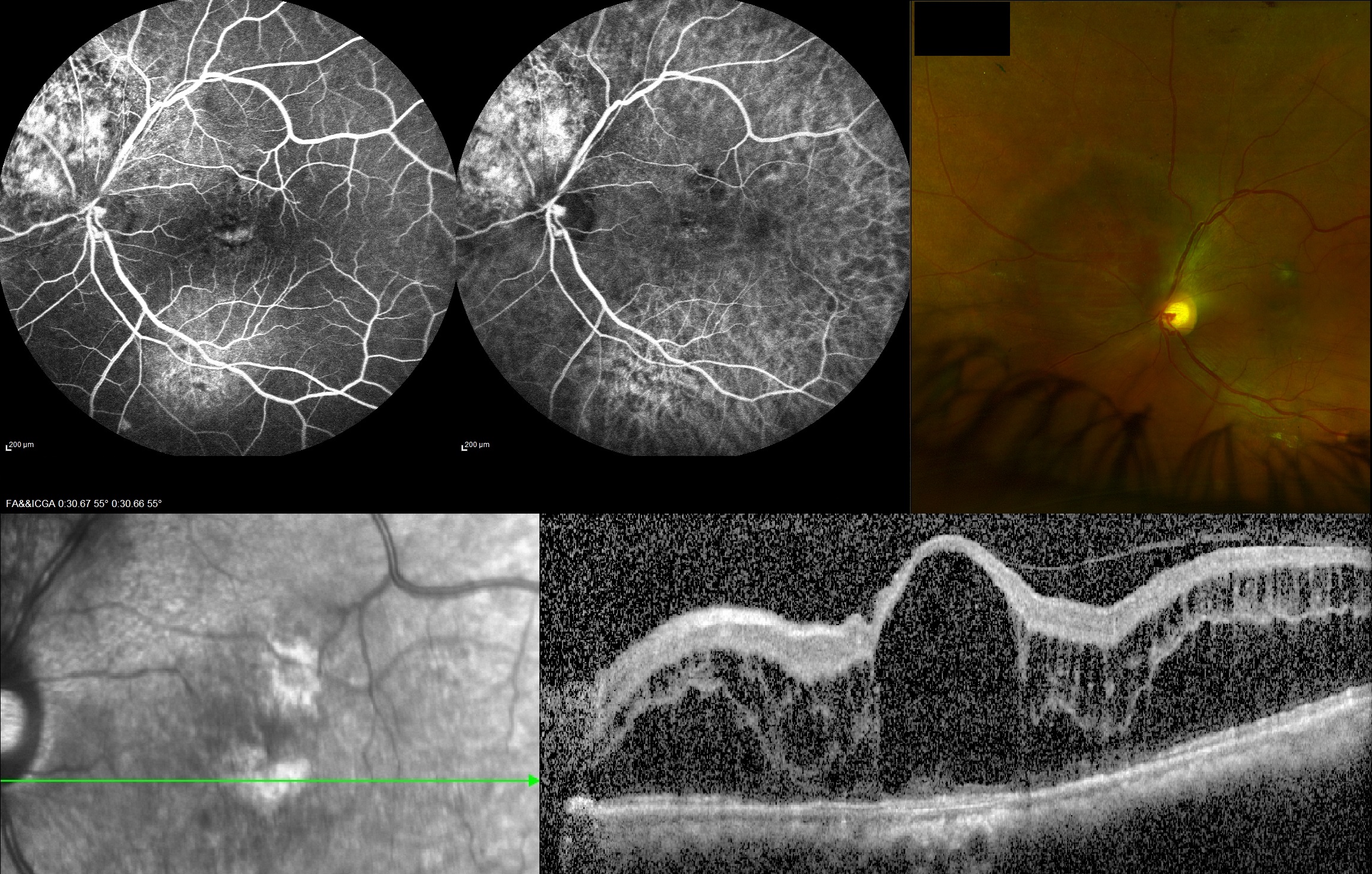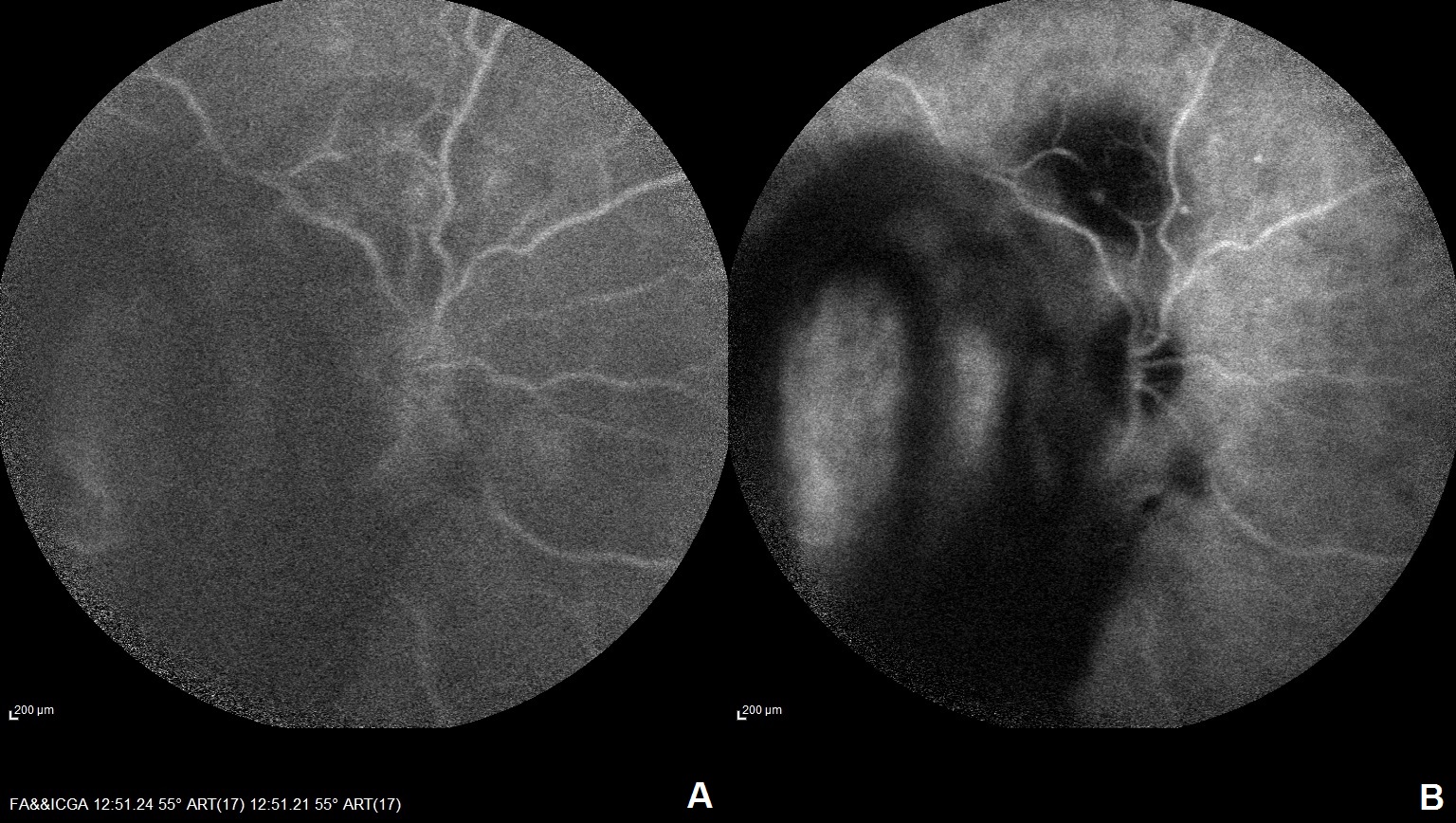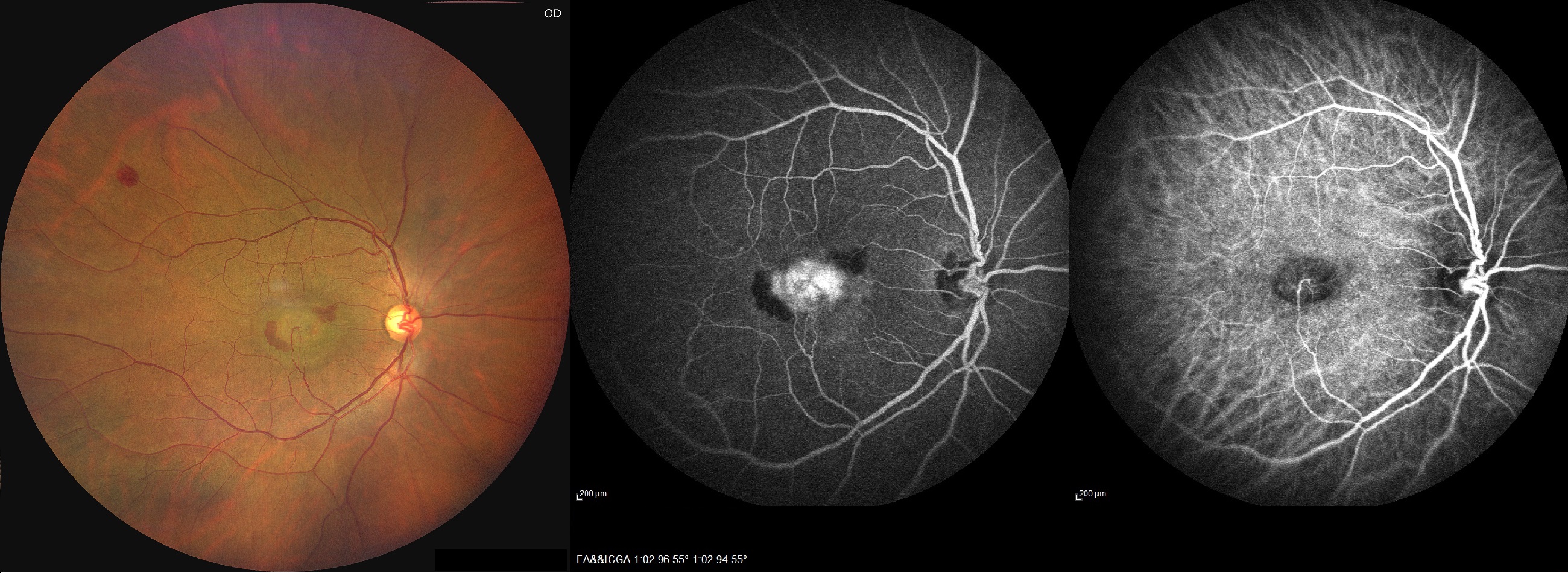[1]
Yannuzzi LA. Indocyanine green angiography: a perspective on use in the clinical setting. American journal of ophthalmology. 2011 May:151(5):745-751.e1. doi: 10.1016/j.ajo.2011.01.043. Epub
[PubMed PMID: 21501704]
Level 3 (low-level) evidence
[3]
Dzurinko VL, Gurwood AS, Price JR. Intravenous and indocyanine green angiography. Optometry (St. Louis, Mo.). 2004 Dec:75(12):743-55
[PubMed PMID: 15624671]
[4]
Invernizzi A, Pellegrini M, Cornish E, Yi Chong Teo K, Cereda M, Chabblani J. Imaging the Choroid: From Indocyanine Green Angiography to Optical Coherence Tomography Angiography. Asia-Pacific journal of ophthalmology (Philadelphia, Pa.). 2020 Jul-Aug:9(4):335-348. doi: 10.1097/APO.0000000000000307. Epub
[PubMed PMID: 32739938]
[5]
Hu J, Qu J, Piao Z, Yao Y, Sun G, Li M, Zhao M. Optical Coherence Tomography Angiography Compared with Indocyanine Green Angiography in Central Serous Chorioretinopathy. Scientific reports. 2019 Apr 16:9(1):6149. doi: 10.1038/s41598-019-42623-x. Epub 2019 Apr 16
[PubMed PMID: 30992527]
[6]
Slakter JS, Yannuzzi LA, Guyer DR, Sorenson JA, Orlock DA. Indocyanine-green angiography. Current opinion in ophthalmology. 1995 Jun:6(3):25-32
[PubMed PMID: 10151085]
Level 3 (low-level) evidence
[7]
Craandijk A, Van Beek CA. Indocyanine green fluorescence angiography of the choroid. The British journal of ophthalmology. 1976 May:60(5):377-85
[PubMed PMID: 952809]
[8]
Wadekar B, Tripathy K, Chawla R, Venkatesh P, Sharma YR, Vohra R. An 18-year-old female with unilateral painless vision loss. Oman journal of ophthalmology. 2016 Sep-Dec:9(3):193
[PubMed PMID: 27843243]
[9]
Tripathy K. Choroidal neovascular membrane in intraocular tuberculosis. GMS ophthalmology cases. 2017:7():Doc24. doi: 10.3205/oc000075. Epub 2017 Sep 1
[PubMed PMID: 28944155]
Level 3 (low-level) evidence
[11]
Paulbuddhe V, Addya S, Gurnani B, Singh D, Tripathy K, Chawla R. Sympathetic Ophthalmia: Where Do We Currently Stand on Treatment Strategies? Clinical ophthalmology (Auckland, N.Z.). 2021:15():4201-4218. doi: 10.2147/OPTH.S289688. Epub 2021 Oct 20
[PubMed PMID: 34707340]
[12]
Hayreh SS. THE OPHTHALMIC ARTERY: III. BRANCHES. The British journal of ophthalmology. 1962 Apr:46(4):212-47
[PubMed PMID: 18170772]
[13]
Hayreh SS. In vivo choroidal circulation and its watershed zones. Eye (London, England). 1990:4 ( Pt 2)():273-89
[PubMed PMID: 2199236]
[14]
Borrelli E, Sarraf D, Freund KB, Sadda SR. OCT angiography and evaluation of the choroid and choroidal vascular disorders. Progress in retinal and eye research. 2018 Nov:67():30-55. doi: 10.1016/j.preteyeres.2018.07.002. Epub 2018 Jul 27
[PubMed PMID: 30059755]
[15]
Zouache MA, Eames I, Klettner CA, Luthert PJ. Form, shape and function: segmented blood flow in the choriocapillaris. Scientific reports. 2016 Oct 25:6():35754. doi: 10.1038/srep35754. Epub 2016 Oct 25
[PubMed PMID: 27779198]
[16]
Hirata Y, Nishiwaki H, Miura S, Ieki Y, Honda Y, Yumikake K, Sugino Y, Okazaki Y. Analysis of choriocapillaris flow patterns by continuous laser-targeted angiography in monkeys. Investigative ophthalmology & visual science. 2004 Jun:45(6):1954-62
[PubMed PMID: 15161863]
[17]
Hayreh SS. Segmental nature of the choroidal vasculature. The British journal of ophthalmology. 1975 Nov:59(11):631-48
[PubMed PMID: 812547]
[18]
Nickla DL, Wallman J. The multifunctional choroid. Progress in retinal and eye research. 2010 Mar:29(2):144-68. doi: 10.1016/j.preteyeres.2009.12.002. Epub 2009 Dec 29
[PubMed PMID: 20044062]
[19]
O'goshi K, Serup J. Safety of sodium fluorescein for in vivo study of skin. Skin research and technology : official journal of International Society for Bioengineering and the Skin (ISBS) [and] International Society for Digital Imaging of Skin (ISDIS) [and] International Society for Skin Imaging (ISSI). 2006 Aug:12(3):155-61
[PubMed PMID: 16827689]
[20]
Grayson MC, Laties AM. Ocular localization of sodium fluorescein. Effects of administration in rabbit and monkey. Archives of ophthalmology (Chicago, Ill. : 1960). 1971 May:85(5):600-3 passim
[PubMed PMID: 4996602]
[21]
Lee A, Ra H, Baek J. Choroidal vascular densities of macular disease on ultra-widefield indocyanine green angiography. Graefe's archive for clinical and experimental ophthalmology = Albrecht von Graefes Archiv fur klinische und experimentelle Ophthalmologie. 2020 Sep:258(9):1921-1929. doi: 10.1007/s00417-020-04772-y. Epub 2020 Jun 3
[PubMed PMID: 32494872]
[22]
Cheung CMG, Lai TYY, Teo K, Ruamviboonsuk P, Chen SJ, Kim JE, Gomi F, Koh AH, Kokame G, Jordan-Yu JM, Corvi F, Invernizzi A, Ogura Y, Tan C, Mitchell P, Gupta V, Chhablani J, Chakravarthy U, Sadda SR, Wong TY, Staurenghi G, Lee WK. Polypoidal Choroidal Vasculopathy: Consensus Nomenclature and Non-Indocyanine Green Angiograph Diagnostic Criteria from the Asia-Pacific Ocular Imaging Society PCV Workgroup. Ophthalmology. 2021 Mar:128(3):443-452. doi: 10.1016/j.ophtha.2020.08.006. Epub 2020 Aug 11
[PubMed PMID: 32795496]
Level 3 (low-level) evidence
[23]
Parravano M, Pilotto E, Musicco I, Varano M, Introini U, Staurenghi G, Menchini U, Virgili G. Reproducibility of fluorescein and indocyanine green angiographic assessment for RAP diagnosis: a multicenter study. European journal of ophthalmology. 2012 Jul-Aug:22(4):598-606. doi: 10.5301/ejo.5000087. Epub
[PubMed PMID: 22139618]
Level 2 (mid-level) evidence
[26]
Moshfeghi AA, Harrison SA, Ferrone PJ. Indocyanine green angiography findings in sympathetic ophthalmia. Ophthalmic surgery, lasers & imaging : the official journal of the International Society for Imaging in the Eye. 2005 Mar-Apr:36(2):163-6
[PubMed PMID: 15792321]
[27]
Agrawal RV, Biswas J, Gunasekaran D. Indocyanine green angiography in posterior uveitis. Indian journal of ophthalmology. 2013 Apr:61(4):148-59. doi: 10.4103/0301-4738.112159. Epub
[PubMed PMID: 23685486]
[28]
Ma CY, Shi JX, Wang HD, Hang CH, Cheng HL, Wu W. Intraoperative indocyanine green angiography in intracranial aneurysm surgery: Microsurgical clipping and revascularization. Clinical neurology and neurosurgery. 2009 Dec:111(10):840-6. doi: 10.1016/j.clineuro.2009.08.017. Epub 2009 Sep 10
[PubMed PMID: 19747765]
[29]
Hardesty DA, Thind H, Zabramski JM, Spetzler RF, Nakaji P. Safety, efficacy, and cost of intraoperative indocyanine green angiography compared to intraoperative catheter angiography in cerebral aneurysm surgery. Journal of clinical neuroscience : official journal of the Neurosurgical Society of Australasia. 2014 Aug:21(8):1377-82. doi: 10.1016/j.jocn.2014.02.006. Epub 2014 Apr 13
[PubMed PMID: 24736193]
[30]
Bischoff PM, Flower RW. Ten years experience with choroidal angiography using indocyanine green dye: a new routine examination or an epilogue? Documenta ophthalmologica. Advances in ophthalmology. 1985 Sep 30:60(3):235-91
[PubMed PMID: 2414083]
Level 3 (low-level) evidence
[31]
Costa DL, Huang SJ, Orlock DA, Freund KB, Yannuzzi LA, Spaide RF, Gross NE. Retinal-choroidal indocyanine green dye clearance and liver dysfunction. Retina (Philadelphia, Pa.). 2003 Aug:23(4):557-61
[PubMed PMID: 12972775]
[32]
Fineman MS, Maguire JI, Fineman SW, Benson WE. Safety of indocyanine green angiography during pregnancy: a survey of the retina, macula, and vitreous societies. Archives of ophthalmology (Chicago, Ill. : 1960). 2001 Mar:119(3):353-5
[PubMed PMID: 11231768]
Level 3 (low-level) evidence
[33]
Hassenstein A, Meyer CH. Clinical use and research applications of Heidelberg retinal angiography and spectral-domain optical coherence tomography - a review. Clinical & experimental ophthalmology. 2009 Jan:37(1):130-43. doi: 10.1111/j.1442-9071.2009.02017.x. Epub
[PubMed PMID: 19338610]
[34]
Cheung CMG, Teo KYC, Tun SBB, Busoy JM, Barathi VA, Spaide RF. Correlation of choriocapillaris hemodynamic data from dynamic indocyanine green and optical coherence tomography angiography. Scientific reports. 2021 Aug 2:11(1):15580. doi: 10.1038/s41598-021-95270-6. Epub 2021 Aug 2
[PubMed PMID: 34341447]
[35]
Stanga PE, Lim JI, Hamilton P. Indocyanine green angiography in chorioretinal diseases: indications and interpretation: an evidence-based update. Ophthalmology. 2003 Jan:110(1):15-21; quiz 22-3
[PubMed PMID: 12511340]
[36]
Prünte C, Flammer J. Choroidal capillary and venous congestion in central serous chorioretinopathy. American journal of ophthalmology. 1996 Jan:121(1):26-34
[PubMed PMID: 8554078]
[37]
Hope-Ross M, Yannuzzi LA, Gragoudas ES, Guyer DR, Slakter JS, Sorenson JA, Krupsky S, Orlock DA, Puliafito CA. Adverse reactions due to indocyanine green. Ophthalmology. 1994 Mar:101(3):529-33
[PubMed PMID: 8127574]
[38]
Haddad WM, Coscas G, Soubrane G. Eligibility for treatment and angiographic features at the early stage of exudative age related macular degeneration. The British journal of ophthalmology. 2002 Jun:86(6):663-9
[PubMed PMID: 12034690]
[39]
Freund KB, Yannuzzi LA, Sorenson JA. Age-related macular degeneration and choroidal neovascularization. American journal of ophthalmology. 1993 Jun 15:115(6):786-91
[PubMed PMID: 7685148]
[40]
Guyer DR, Yannuzzi LA, Slakter JS, Sorenson JA, Hanutsaha P, Spaide RF, Schwartz SG, Hirschfeld JM, Orlock DA. Classification of choroidal neovascularization by digital indocyanine green videoangiography. Ophthalmology. 1996 Dec:103(12):2054-60
[PubMed PMID: 9003339]
[41]
Yannuzzi LA, Hope-Ross M, Slakter JS, Guyer DR, Sorenson JA, Ho AC, Sperber DE, Freund KB, Orlock DA. Analysis of vascularized pigment epithelial detachments using indocyanine green videoangiography. Retina (Philadelphia, Pa.). 1994:14(2):99-113
[PubMed PMID: 7518607]
[42]
Gass JD. Serous retinal pigment epithelial detachment with a notch. A sign of occult choroidal neovascularization. Retina (Philadelphia, Pa.). 1984 Fall-Winter:4(4):205-20
[PubMed PMID: 6085179]
[43]
Kim H, Lee SC, Kim SM, Lee JH, Koh HJ, Kim SS, Byeon SH, Kim M, Lee CS. Identification of Underlying Causes of Spontaneous Submacular Hemorrhage by Indocyanine Green Angiography. Ophthalmologica. Journal international d'ophtalmologie. International journal of ophthalmology. Zeitschrift fur Augenheilkunde. 2015:233(3-4):146-54. doi: 10.1159/000380830. Epub 2015 Mar 26
[PubMed PMID: 25833061]
[44]
Hlushchuk R, Baum O, Gruber G, Wood J, Djonov V. The synergistic action of a VEGF-receptor tyrosine-kinase inhibitor and a sensitizing PDGF-receptor blocker depends upon the stage of vascular maturation. Microcirculation (New York, N.Y. : 1994). 2007 Nov-Dec:14(8):813-25
[PubMed PMID: 17907017]
[45]
Massacesi AL, Sacchi L, Bergamini F, Bottoni F. The prevalence of retinal angiomatous proliferation in age-related macular degeneration with occult choroidal neovascularization. Graefe's archive for clinical and experimental ophthalmology = Albrecht von Graefes Archiv fur klinische und experimentelle Ophthalmologie. 2008 Jan:246(1):89-92
[PubMed PMID: 17653567]
[46]
Kuhn D, Meunier I, Soubrane G, Coscas G. Imaging of chorioretinal anastomoses in vascularized retinal pigment epithelium detachments. Archives of ophthalmology (Chicago, Ill. : 1960). 1995 Nov:113(11):1392-8
[PubMed PMID: 7487600]
[47]
Bressler NM. Retinal anastomosis to choroidal neovascularization: a bum rap for a difficult disease. Archives of ophthalmology (Chicago, Ill. : 1960). 2005 Dec:123(12):1741-3
[PubMed PMID: 16344449]
[48]
Ghazi NG, Knape RM, Kirk TQ, Tiedeman JS, Conway BP. Intravitreal bevacizumab (avastin) treatment of retinal angiomatous proliferation. Retina (Philadelphia, Pa.). 2008 May:28(5):689-95. doi: 10.1097/IAE.0b013e318162d982. Epub
[PubMed PMID: 18463511]
[49]
Bottoni F, Massacesi A, Cigada M, Viola F, Musicco I, Staurenghi G. Treatment of retinal angiomatous proliferation in age-related macular degeneration: a series of 104 cases of retinal angiomatous proliferation. Archives of ophthalmology (Chicago, Ill. : 1960). 2005 Dec:123(12):1644-50
[PubMed PMID: 16344434]
Level 3 (low-level) evidence
[50]
Rouvas AA, Papakostas TD, Vavvas D, Vergados I, Moschos MM, Kotsolis A, Ladas ID. Intravitreal ranibizumab, intravitreal ranibizumab with PDT, and intravitreal triamcinolone with PDT for the treatment of retinal angiomatous proliferation: a prospective study. Retina (Philadelphia, Pa.). 2009 Apr:29(4):536-44. doi: 10.1097/IAE.0b013e318196b1de. Epub
[PubMed PMID: 19190547]
[51]
Saito M, Shiragami C, Shiraga F, Kano M, Iida T. Comparison of intravitreal triamcinolone acetonide with photodynamic therapy and intravitreal bevacizumab with photodynamic therapy for retinal angiomatous proliferation. American journal of ophthalmology. 2010 Mar:149(3):472-81.e1. doi: 10.1016/j.ajo.2009.09.016. Epub 2010 Jan 6
[PubMed PMID: 20053392]
[52]
Koh AH, Expert PCV Panel, Chen LJ, Chen SJ, Chen Y, Giridhar A, Iida T, Kim H, Yuk Yau Lai T, Lee WK, Li X, Han Lim T, Ruamviboonsuk P, Sharma T, Tang S, Yuzawa M. Polypoidal choroidal vasculopathy: evidence-based guidelines for clinical diagnosis and treatment. Retina (Philadelphia, Pa.). 2013 Apr:33(4):686-716. doi: 10.1097/IAE.0b013e3182852446. Epub
[PubMed PMID: 23455233]
Level 1 (high-level) evidence
[53]
Yannuzzi LA, Sorenson J, Spaide RF, Lipson B. Idiopathic polypoidal choroidal vasculopathy (IPCV). Retina (Philadelphia, Pa.). 1990:10(1):1-8
[PubMed PMID: 1693009]
[54]
Koh A, Lee WK, Chen LJ, Chen SJ, Hashad Y, Kim H, Lai TY, Pilz S, Ruamviboonsuk P, Tokaji E, Weisberger A, Lim TH. EVEREST study: efficacy and safety of verteporfin photodynamic therapy in combination with ranibizumab or alone versus ranibizumab monotherapy in patients with symptomatic macular polypoidal choroidal vasculopathy. Retina (Philadelphia, Pa.). 2012 Sep:32(8):1453-64
[PubMed PMID: 22426346]
[55]
Lai TY, Chan WM, Liu DT, Luk FO, Lam DS. Intravitreal bevacizumab (Avastin) with or without photodynamic therapy for the treatment of polypoidal choroidal vasculopathy. The British journal of ophthalmology. 2008 May:92(5):661-6. doi: 10.1136/bjo.2007.135103. Epub 2008 Mar 20
[PubMed PMID: 18356265]
[56]
Goldman DR, Freund KB, McCannel CA, Sarraf D. Peripheral polypoidal choroidal vasculopathy as a cause of peripheral exudative hemorrhagic chorioretinopathy: a report of 10 eyes. Retina (Philadelphia, Pa.). 2013 Jan:33(1):48-55. doi: 10.1097/IAE.0b013e31825df12a. Epub
[PubMed PMID: 22836900]
[57]
Spaide RF, Hall L, Haas A, Campeas L, Yannuzzi LA, Fisher YL, Guyer DR, Slakter JS, Sorenson JA, Orlock DA. Indocyanine green videoangiography of older patients with central serous chorioretinopathy. Retina (Philadelphia, Pa.). 1996:16(3):203-13
[PubMed PMID: 8789858]
[58]
Yannuzzi LA, Slakter JS, Gross NE, Spaide RF, Costa D, Huang SJ, Klancnik JM Jr, Aizman A. Indocyanine green angiography-guided photodynamic therapy for treatment of chronic central serous chorioretinopathy: a pilot study. Retina (Philadelphia, Pa.). 2003 Jun:23(3):288-98
[PubMed PMID: 12824827]
Level 3 (low-level) evidence
[59]
Yannuzzi LA, Freund KB, Goldbaum M, Scassellati-Sforzolini B, Guyer DR, Spaide RF, Maberley D, Wong DW, Slakter JS, Sorenson JA, Fisher YL, Orlock DA. Polypoidal choroidal vasculopathy masquerading as central serous chorioretinopathy. Ophthalmology. 2000 Apr:107(4):767-77
[PubMed PMID: 10768341]
[60]
Guyer DR, Yannuzzi LA, Slakter JS, Sorenson JA, Ho A, Orlock D. Digital indocyanine green videoangiography of central serous chorioretinopathy. Archives of ophthalmology (Chicago, Ill. : 1960). 1994 Aug:112(8):1057-62
[PubMed PMID: 8053819]
[61]
Tsujikawa A, Ojima Y, Yamashiro K, Ooto S, Tamura H, Nakagawa S, Yoshimura N. Punctate hyperfluorescent spots associated with central serous chorioretinopathy as seen on indocyanine green angiography. Retina (Philadelphia, Pa.). 2010 May:30(5):801-9. doi: 10.1097/IAE.0b013e3181c72068. Epub
[PubMed PMID: 20094008]
[62]
Chung H, Byeon SH, Freund KB. FOCAL CHOROIDAL EXCAVATION AND ITS ASSOCIATION WITH PACHYCHOROID SPECTRUM DISORDERS: A Review of the Literature and Multimodal Imaging Findings. Retina (Philadelphia, Pa.). 2017 Feb:37(2):199-221. doi: 10.1097/IAE.0000000000001345. Epub
[PubMed PMID: 27749784]
[63]
Cheung CMG, Lee WK, Koizumi H, Dansingani K, Lai TYY, Freund KB. Pachychoroid disease. Eye (London, England). 2019 Jan:33(1):14-33. doi: 10.1038/s41433-018-0158-4. Epub 2018 Jul 11
[PubMed PMID: 29995841]
[64]
Schneider U, Wagner AL, Kreissig I. Indocyanine green videoangiography of hemorrhagic retinal arterial macroaneurysms. Ophthalmologica. Journal international d'ophtalmologie. International journal of ophthalmology. Zeitschrift fur Augenheilkunde. 1997:211(2):115-8
[PubMed PMID: 9097320]
[65]
Mueller AJ, Freeman WR, Schaller UC, Kampik A, Folberg R. Complex microcirculation patterns detected by confocal indocyanine green angiography predict time to growth of small choroidal melanocytic tumors: MuSIC Report II. Ophthalmology. 2002 Dec:109(12):2207-14
[PubMed PMID: 12466160]
[66]
Arevalo JF, Shields CL, Shields JA, Hykin PG, De Potter P. Circumscribed choroidal hemangioma: characteristic features with indocyanine green videoangiography. Ophthalmology. 2000 Feb:107(2):344-50
[PubMed PMID: 10690837]
[67]
Howe LJ, Stanford MR, Graham EM, Marshall J. Choroidal abnormalities in birdshot chorioretinopathy: an indocyanine green angiography study. Eye (London, England). 1997:11 ( Pt 4)():554-9
[PubMed PMID: 9425423]
[68]
Slakter JS, Giovannini A, Yannuzzi LA, Scassellati-Sforzolini B, Guyer DR, Sorenson JA, Spaide RF, Orlock D. Indocyanine green angiography of multifocal choroiditis. Ophthalmology. 1997 Nov:104(11):1813-9
[PubMed PMID: 9373111]
[69]
Dell'omo R, Wong R, Marino M, Konstantopoulou K, Pavesio C. Relationship between different fluorescein and indocyanine green angiography features in multiple evanescent white dot syndrome. The British journal of ophthalmology. 2010 Jan:94(1):59-63. doi: 10.1136/bjo.2009.163550. Epub 2009 Aug 18
[PubMed PMID: 19692364]
[70]
Giovannini A, Mariotti C, Ripa E, Scassellati-Sforzolini B. Indocyanine green angiographic findings in serpiginous choroidopathy. The British journal of ophthalmology. 1996 Jun:80(6):536-40
[PubMed PMID: 8759265]
[71]
Howe LJ, Woon H, Graham EM, Fitzke F, Bhandari A, Marshall J. Choroidal hypoperfusion in acute posterior multifocal placoid pigment epitheliopathy. An indocyanine green angiography study. Ophthalmology. 1995 May:102(5):790-8
[PubMed PMID: 7777278]
[72]
Tiffin PA, Maini R, Roxburgh ST, Ellingford A. Indocyanine green angiography in a case of punctate inner choroidopathy. The British journal of ophthalmology. 1996 Jan:80(1):90-1
[PubMed PMID: 8664243]
Level 3 (low-level) evidence
[73]
Levy J, Shneck M, Klemperer I, Lifshitz T. Punctate inner choroidopathy: resolution after oral steroid treatment and review of the literature. Canadian journal of ophthalmology. Journal canadien d'ophtalmologie. 2005 Oct:40(5):605-8
[PubMed PMID: 16391624]
[74]
Mrejen S, Khan S, Gallego-Pinazo R, Jampol LM, Yannuzzi LA. Acute zonal occult outer retinopathy: a classification based on multimodal imaging. JAMA ophthalmology. 2014 Sep:132(9):1089-98. doi: 10.1001/jamaophthalmol.2014.1683. Epub
[PubMed PMID: 24945598]
[75]
Giani A, Pellegrini M, Carini E, Peroglio Deiro A, Bottoni F, Staurenghi G. The dark atrophy with indocyanine green angiography in Stargardt disease. Investigative ophthalmology & visual science. 2012 Jun 26:53(7):3999-4004. doi: 10.1167/iovs.11-9258. Epub 2012 Jun 26
[PubMed PMID: 22589445]
[76]
Bernasconi O, Auer C, Zografos L, Herbort CP. Indocyanine green angiographic findings in sympathetic ophthalmia. Graefe's archive for clinical and experimental ophthalmology = Albrecht von Graefes Archiv fur klinische und experimentelle Ophthalmologie. 1998 Aug:236(8):635-8
[PubMed PMID: 9717662]
[77]
Herbort CP, Mantovani A, Bouchenaki N. Indocyanine green angiography in Vogt-Koyanagi-Harada disease: angiographic signs and utility in patient follow-up. International ophthalmology. 2007 Apr-Jun:27(2-3):173-82
[PubMed PMID: 17457515]
[78]
Bouchenaki N, Herbort CP. Indocyanine green angiography guided management of vogt-koyanagi-harada disease. Journal of ophthalmic & vision research. 2011 Oct:6(4):241-8
[PubMed PMID: 22454746]




